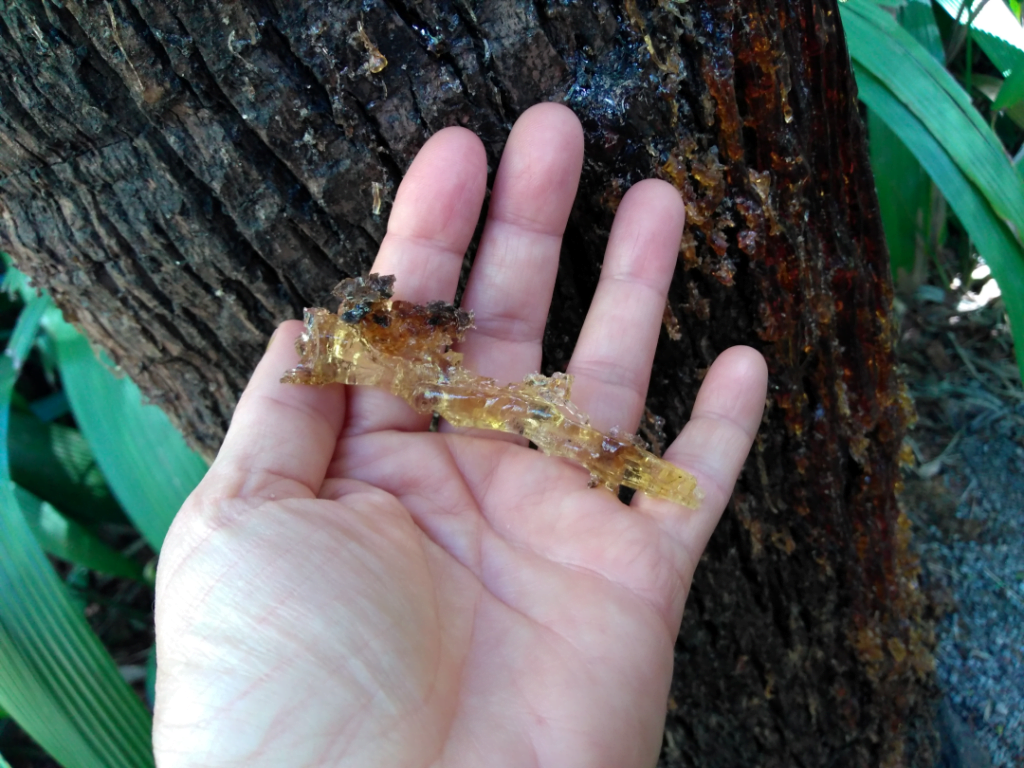
When it comes to outdoor activities, encountering tree sap on your hands can be a common and frustrating occurrence. Tree sap is a natural adhesive that trees produce to seal off wounds or protect themselves from pests. It is sticky and can harden over time, making it challenging to remove from surfaces. When tree sap comes into contact with your hands, it can quickly adhere to your skin, creating a sticky mess.
Whether you have been gardening, camping, or simply taking a walk in nature, getting tree sap on your hands is something most people have experienced at least once. In this article, we will explore the risk of getting tree sap on your hands, the methods on how to get tree sap off hands, and tips to prevent it from getting on your hands.
What Are the Risks of Leaving Tree Sap on Your Hands?
Leaving tree sap on your hands for an extended period can have some risks. Tree sap contains natural resins and chemicals that can irritate your skin. If you have sensitive skin, prolonged exposure to sap can cause redness, itching, and even an allergic reaction. Moreover, the sticky nature of the sap can attract dirt and bacteria, increasing the risk of skin infections.
The Importance of Removing Tree Sap from Hands
Can Tree Sap Cause Any Health Issues?
While tree sap is generally not harmful to your health, it can cause discomfort and irritation if left on your hands for too long. Some individuals may have allergic reactions to the chemicals present in the sap, resulting in skin rashes or itching. It is essential to clean your hands promptly to avoid any potential health issues.
Can Tree Sap Damage Your Skin or Hair?
Tree sap is not known to cause significant damage to your skin or hair. However, as mentioned earlier, prolonged exposure to sap can lead to skin irritation and allergic reactions in some individuals. Additionally, the sticky texture of the sap can make it challenging to remove from your hair, causing knots and tangles.
Thus, removing tree sap promptly from your hands is crucial for several reasons. First, it helps prevent potential allergic reactions or skin irritations. Second, it helps maintain good hand hygiene by removing any dirt or bacteria that may have been attracted to the sticky sap. Lastly, timely removal can prevent the sap from hardening and becoming more difficult to remove later on.
What To Do if Tree Sap Gets on Your Skin and Hair?

If tree sap gets on your skin and hair, here are some steps to remove the sticky substance and effectively prevent discomfort:
- Stay calm and avoid panic. Stay calm and avoid rubbing the sap further into your skin or hair. Panic may lead to more extensive contact with the sap and worsen the situation.
- Gently wipe off excess sap. Use a clean cloth or paper towel to gently wipe off as much of the tree sap as possible from your skin and hair. Be careful not to apply too much pressure, which can spread the sap or cause it to stick more.
- Wash with soap and water. Head to a sink or use a water bottle to rinse the affected areas with soap and water. Thoroughly lather the soap and gently wash the sap-covered skin and hair to remove any remaining residue.
- Use oil or grease-removing soap. If the sap proves stubborn, consider using oil, such as olive or coconut, to break down the sap. Rub the oil gently onto the affected areas and let it sit for a few minutes before rinsing with soap and water. Alternatively, you can use a grease-removing soap to help dissolve the sap.
- Comb out hair carefully. If the sap is stuck in your hair, use a wide-toothed comb to detangle and remove the sap from your hair carefully. Start at the tips and work your way up to prevent hair breakage.
- Apply conditioner. After removing the sap, apply a conditioner to your hair to restore moisture and soften the strands. Leave the conditioner on for a few minutes before rinsing thoroughly.
- Use commercial sap remover. If home remedies don’t work, you can consider using a commercial sap remover or adhesive remover. Follow the product’s instructions carefully to remove the sap safely.
- Avoid harsh chemicals. Be cautious when using harsh chemicals or solvents to remove sap, as they irritate your skin or damage your hair. Opt for natural remedies or mild solutions whenever possible.
- Stay hydrated. Drinking plenty of water can help flush out any sap residue from your body and keep your skin hydrated.
- Seek medical advice if necessary. If you experience skin irritation or allergic reactions due to the tree sap, seek medical advice promptly.
Remember, prevention is always better than cure. Staying proactive and taking immediate action can help you handle tree sap mishaps effectively and restore your skin and hair to its normal condition.
8 Fast and Effective Methods on How to Get Tree Sap Off Hands
1. Using Hand Sanitizer
Hand sanitizer is an effective and convenient method for removing tree sap from your hands. The alcohol content in the sanitizer helps break down the sticky sap, making it easier to remove. Simply apply a generous amount of hand sanitizer to the affected area and rub it in. After a few seconds, the sap should start to dissolve. Rinse your hands with warm water and soap to remove any residue.
2. Using Peanut Butter
Peanut butter is another surprising but effective method for removing tree sap from your hands. The oils in peanut butter help break down the sap, making it easier to wash away. Apply a thick layer of peanut butter to the sap-covered area and gently rub it in. Allow it to sit for a few minutes, then rinse off with warm water and soap. The sap should come off along with the peanut butter.
3. Using Rubbing Alcohol
Rubbing alcohol, or isopropyl alcohol, is a common household item that can help remove tree sap from your hands. Wet a cotton ball or pad with rubbing alcohol and gently rub it over the affected area. The alcohol will dissolve the sap, allowing you to wipe it away easily. Remember to wash your hands with soap and warm water afterward to remove any alcohol residue.
4. Using Cooking Oil
Another way to remove sap from your hands is by using cooking oil. Pour some cooking oil into a small bowl and warm it over low heat on the stovetop or in an electric skillet. Dip one hand into the oil for about a minute, then rub it gently all over your hands (don’t rub too hard or scrub off all the oil).
Rubbing helps loosen up any remaining sap so it can be easily removed with a paper towel or cloth towel. Once the sap has been loosened up, wash your hand with gentle soap and use a cloth towel to wipe away any residue from your skin surface or clothing.
5. Using Warm Water and Soap
If you don’t have hand sanitizer or rubbing alcohol on your hands, warm water and soap can still effectively remove tree sap. Start by rinsing your hands with warm water to soften the sap. Then, apply a generous amount of soap and lather up. Gently scrub the affected areas, focusing on the sap-covered spots. Rinse thoroughly with warm water to remove all the sap and soap residue.
6. Using Mayonnaise
Mayonnaise may seem unconventional, but its oil-based nature can help break down tree sap. Apply a thick layer of mayonnaise to the sap-covered area and let it sit for a few minutes. The oils in the mayonnaise will start to dissolve the sap. Gently wipe away the sap and mayonnaise with a clean cloth or paper towel. Wash your hands with warm water and soap to remove any remaining residue.
7. Using Dish Soap
If dish soap is available, it can also be an effective option for removing tree sap from your hands. Make sure to choose a dish soap formulated to cut through grease. Apply a small dish soap to the sap-covered area and lather up. Gently rub your hands together, focusing on the spots with sap. Rinse thoroughly with warm water to remove all traces of sap and soap.
Always test any new solution on a small area of your skin to ensure you don’t have any adverse reactions or allergies to the products.
8. Baby Shampoo
Baby shampoo works even better than hand sanitizer if you have lots of sap on your hands. Just wet your hands and rub them in with the baby shampoo until it’s all gone. Repeat this process until the sap comes off cleanly with little effort (usually 3-5 times). You can also use it to remove sap from skin and hair covered in sap by accident.
How To Prevent Tree Sap From Getting on Your Hands

Preventing tree sap from getting on your hands can save you from sticky situations. Here are some practical tips to keep your hands sap-free:
- Wear Gloves: One of the most effective ways to prevent tree sap from getting on your hands is to wear gloves while working with trees or plants. Choose gloves made of latex or nitrile, which offer good protection against sap.
- Avoid Touching Fresh Cuts: Avoid touching the exposed areas if you’re pruning or handling freshly cut branches. Sap is more likely to ooze from fresh cuts, so keeping your hands away from these areas can help you stay sap-free.
- Wash Hands Regularly: After working with trees or plants, make it a habit to wash your hands thoroughly with soap and water. This can help remove any sap that might have accidentally come into contact with your skin.
- Use Barrier Creams: Applying a barrier cream or lotion to your hands before working with trees can create a protective layer that prevents sap from sticking to your skin.
- Keep Hand Sanitizer Handy: If you can’t immediately wash your hands after coming into contact with tree sap, use hand sanitizer with a high alcohol content to help dissolve the sap and make it easier to remove later.
- Be Cautious Around Sticky Trees: Some species, like pines and firs, produce more sap than others. Be extra cautious when working with these trees to avoid getting sap on your hands.
- Use Hand Wipes: Carry hand wipes or moist towels in your pocket or bag outdoors. These can be handy for quick cleanups if you accidentally touch tree sap.
- Rinse with Water: If you get sap on your hands, rinse them with water as soon as possible. The sooner you remove the sap, the easier it will be to clean your hands thoroughly.
- Trim Branches Carefully: When trimming branches or twigs, do it in a controlled manner to minimize sap release. Cutting at a slight angle away from the trunk can help reduce sap flow.
- Choose Less Sap-Producing Trees: If you’re planting trees in your yard or garden, consider choosing species that produce less sap to reduce the likelihood of getting it on your hands.
By incorporating these preventive measures into your outdoor activities, you can enjoy working with trees and plants without worrying about getting tree sap on your hands. Staying proactive and taking simple precautions can make a significant difference in keeping your hands sap-free.
Frequently Asked Questions
Q: How do I remove tree sap from my hands effectively?
A: To effectively remove tree sap from your hands, you can try various methods such as using soap and water, nail polish remover, rubbing alcohol, or a commercial sap remover.
Q: How To Remove Pine Tree Sap From Your Hands
A: To remove pine tree sap from your hands, you can follow similar methods, such as hand sanitizer, peanut butter, warm water, soap, or rubbing alcohol. Also, gently scrubbing with a soft brush can help remove residual sap.
Q: How do I remove tree sap from my car?
A: Consider using a commercial sap remover to remove tree sap from your car. These products are formulated to dissolve tree sap without damaging your car’s paint. Follow the instructions on the product’s label, and always test it on a small, inconspicuous area of your car first to ensure compatibility with the paint.
Q: Can you suggest easy and effective ways to get sap off my skin and hair?
A: There are several easy and effective ways to remove tree sap from your skin and hair. Some methods include using rubbing alcohol, peanut butter, vegetable oil, or a mixture of baking soda and water.
Q: What should I do if I accidentally get pine sap on my hands?
A: If you accidentally get pine sap on your hands, you can try using soap and water to wash it off. If that doesn’t work, you can use rubbing alcohol or nail polish remover to remove the sap gently.
Q: Are there any specific methods to safely remove tree sap from my skin and hair?
A: There are specific methods to remove tree sap from your skin and hair safely. You can use various home remedies such as rubbing alcohol, cooking oil, or even mayonnaise. Just make sure to clean the affected area and rinse thoroughly afterward gently.
Q: Can you recommend a reliable sap remover for easy cleanup?
A: Yes, several reliable sap removers are available in the market. Some popular options include commercial sap removers, dishwashing soap with grease-cutting properties, or even specialized hand soaps designed for removing tough stains like sap.
Q: How can I get tree sap off my hands without causing skin irritation?
A: To get tree sap off your hands without irritation, use gentle home remedies such as rubbing alcohol, baby oil, or warm soapy water. These methods are less likely to irritate compared to harsh chemicals.
Q: How do I get tree sap off my hands if I don’t have a commercial sap remover?
A: If you don’t have a commercial sap remover, use everyday household items such as rubbing alcohol, nail polish remover (acetone-based), cooking oil, or even mayonnaise. These can help break down the sap and make it easier to remove.
Q: Does Vinegar Remove Sap?
A: Yes, vinegar can remove tree sap. Vinegar has acidic properties that help remove tree sap from hands, clothes, carpets, cars, hair, and skin. Vinegar is a good choice for removing tree sap because it has a low pH (around 4).
You can either spray or pour diluted vinegar directly onto the affected area or use a soft brush to dab away any excess liquid from the leaves of your trees with a cloth or piece of paper towel that you dampen with water first before applying the vinegar solution directly onto the affected area on your trees leaves.
Conclusion: Choose the Method That Works Best for You
In conclusion, several effective techniques exist when removing tree sap from your hands. Choosing the method that works best for you is essential for a hassle-free cleanup. Whether you opt for hand sanitizer, peanut butter, rubbing alcohol, or any other technique, the key is to act promptly to prevent any potential skin irritations or discomfort. Following these easy and effective methods, you can quickly eliminate tree sap and enjoy smooth, sap-free hands!
For more valuable content like this, join our community at the Family Hint today!




